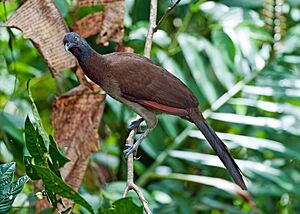Grey-headed chachalaca facts for kids
Quick facts for kids Grey-headed chachalaca |
|
|---|---|
 |
|
| At Cordillera de Talamanca, Costa Rica | |
| Conservation status | |
| Scientific classification | |
| Genus: |
Ortalis
|
| Species: |
cinereiceps
|
 |
|
The grey-headed chachalaca (Ortalis cinereiceps) is a type of bird that belongs to an old family called Cracidae. This family also includes other cool birds like guans and curassows. You can find these chachalacas living in areas from Honduras all the way down to Colombia.
Contents
About the Grey-headed Chachalaca's Family
The family of birds that grey-headed chachalacas belong to, Cracidae, is closely related to other bird groups. These include guineafowl (Numididae), pheasants and grouse (Phasianidae), and New World quail (Odontophoridae).
Scientists once thought the grey-headed chachalaca was the same species as the chestnut-winged chachalaca (Ortalis garrula). However, they are now known to be different. The grey-headed chachalaca is a unique species, meaning it does not have different types or subspecies.
What Does a Grey-headed Chachalaca Look Like?
The grey-headed chachalaca is a medium-sized bird. It looks a bit like a small turkey. It has a small head, strong, long legs, and a long, wide tail.
These birds are about 48 to 58 cm (1.6 to 1.9 ft) long. They weigh between 490 to 540 g (1.1 to 1.2 lb). Their feathers are usually a bit dull. They are grayish-brown on top and lighter underneath.
Their head is dark grey, and they have a red dewlap (a flap of skin) under their chin. Their tail is blackish with a buff-colored tip. The main flight feathers on their wings are a bright chestnut color. Young chachalacas are browner all over, especially on their heads.
Where Do Grey-headed Chachalacas Live?
You can find the grey-headed chachalaca in a wide area. This includes Mosquitia in eastern Honduras, eastern Nicaragua, most of Costa Rica and Panama. They also live in Colombia's Chocó Department.
Besides mainland Panama, they are also found on Isla del Rey. They might have been brought there by native people a long time ago.
These birds live in many different wet places with thick plants. This includes dense bushes, young forests that have grown back, old fields with lots of brush, and thin forests. They do not like to go deep into thick forests. However, they can be found along the edges. They live from sea level up to about 1,700 m (5,600 ft) high.
How Do Grey-headed Chachalacas Behave?
What Do Grey-headed Chachalacas Eat?
Grey-headed chachalacas usually look for food in groups. These groups often have six to 12 birds, but sometimes up to 20. They mostly forage in plants, but sometimes they search for food on the ground.
Their diet is mostly fruit, making up about 75% of what they eat. About 17% of their diet is leaves, and 8% is small bugs. During the dry season, they visit rivers in the morning and evening to drink water.
Reproduction and Life Cycle
The grey-headed chachalaca's egg-laying season lasts from at least January to May. This time overlaps with the dry season. Their nest is wide and shallow. It is built from twigs, vines, and other plant materials.
They build their nests about 1 to 2.4 m (3 to 8 ft) above the ground. Nests are often in a tree or bush and hidden by vines. The female bird lays three dull white eggs. She sits on the eggs alone to keep them warm until they hatch.
What Sounds Do Grey-headed Chachalacas Make?
The grey-headed chachalaca is not as loud as some other chachalacas. For example, the plain chachalaca (O. vetula) or rufous-vented chachalaca (O. ruficauda) are noisier.
Their song is a soft "cha-cha-lac-ah." When they are in a group, they make loud calls that sound like "kloik, kleeuk kraahk." They also make different screams, sharp alarm calls, and a quiet purr sound.
Conservation Status: Are They Safe?
The IUCN (International Union for Conservation of Nature) has looked at the grey-headed chachalaca. They have decided that this bird is of Least Concern. This means they are not currently in danger of disappearing.
These birds are fairly common to common throughout the places they live. However, in some areas, hunting has caused their numbers to go down. Luckily, they can adapt well to some changes in their habitat.



